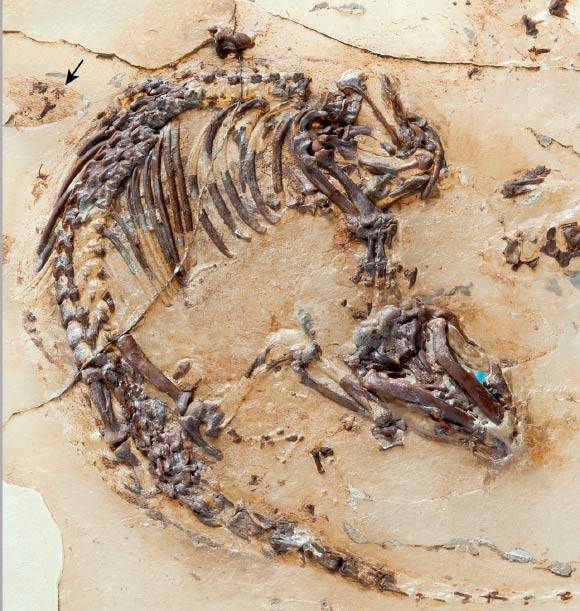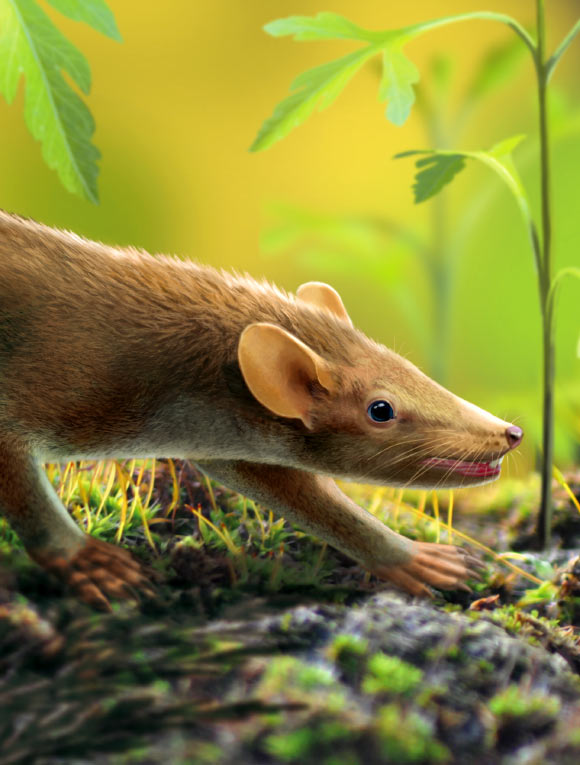An international team of paleontologists has discovered a 125-million-year-old ancient mammal fossil, which has been named a new species, in Spain. According to the team, the discovery pushes back the earliest record of preserved mammalian hair structures and inner organs by more than 60 million years.
The specimen, named Spinolestes xenarthrosus, was fossilized with remarkably intact guard hairs, underfur, tiny hedgehog-like spines and even evidence of a fungal hair infection.
“Spinolestes xenarthrosus is a spectacular find. It is stunning to see almost perfectly preserved skin and hair structures fossilized in microscopic detail in such an old fossil,” said Dr Zhe-Xi Luo of the University of Chicago.
“This Cretaceous furball displays the entire structural diversity of modern mammalian skin and hairs.”
Spinolestes xenarthrosus lived in what is now Spain in the Cretaceous period, about 125 million years ago. It belonged to Eutriconodonta (triconodonts), an order of early mammals
The animal when alive was about 9.5 inches (24 cm) long and weighed 50 to 70 grams, about the size of a modern-day juvenile rat. Its teeth and skeletal features indicate it was a ground-dweller that ate insects.
Its soft tissues, with discernable microscopic structures, were preserved through a process known as phosphatic fossilization.
Individual hair follicles and bulbs, as well as the composition of individual hair shafts, could be identified using an electron scanning microscope.
According to the paleontologists, Spinolestes xenarthrosus had remarkably modern mammalian hair and skin structures, such as compound follicles in which multiple hairs emerge from the same pore. It had small spines around a tenth of a millimeter in diameter on its back.
“We are familiar with these characteristics in modern spiny mice from Africa and Asia Minor. If a predator grabs them by the back, the spines detach from the skin. The mouse can escape and the attacker is left with nothing more than a mouthful of spines,” said Prof. Thomas Martin of the University of Bonn, Germany.
The scientists even found abnormally truncated hairs that are evidence of a fungal skin infection known as dermatophytosis, which is widely seen among living mammals.
“Hairs and hair-related integumentary structures are fundamental to the livelihood of mammals, and this fossil shows that an ancestral, long-extinct lineage had grown these structures in exactly the same way that modern mammals do,” Dr Luo said.
“Spinolestes xenarthrosus gives us a spectacular revelation about this central aspect of mammalian biology.”

Skeleton of Spinolestes xenarthrosus with preserved fur shadows; the outer ear can be seen at the upper edge of the photo – arrow. Image credit: Georg Oleschinski / Thomas Martin et al.
The finding comes from the Las Hoyas Quarry in east-central Spain, which has primarily been known up to now for its well-preserved bird and reptile fossils. However, in 2011, the paleontologists encountered the fossilized skeleton of a previously unknown mammal there.
Spinolestes xenarthrosus is also the first example of a Mesozoic mammal in which soft tissues in the thoracic and abdominal cavities are fossilized.
The paleontologists noted microscopic bronchiole structures of the lung, as well as iron-rich residues associated with the liver. These areas were separated by a curved boundary that is thought to be a muscular diaphragm for respiration.
This represents the earliest-known record of mammalian organ systems.
The fossil of Spinolestes xenarthrosus contains a large external ear, the earliest-known example in the mammalian fossil record, as well as dermal scutes – plate-like structures made of skin keratin.
The animal had extra articulations between vertebrae, which strengthened its spinal column – modern-day mammals such as armored shrews and armadillos possess similar articulations. The scientists speculate that this might provide a clue as to the animal’s lifestyle.
“Similar structures are found today in armadillos and anteaters but also in the African hero shrew. For instance, the hero shrew uses its strong back to break off palm fronds from the trunk of the tree. In this way, it can reach insect larvae living between the attachment points of the fronds and the trunk,” Prof. Martin said.
He added: “125 million years ago, Spinolestes xenarthrosus was very well adapted to its ecological niche – through horny scutes and spines on its back as well as through its reinforced spine.”
“The fossil thus joins the ranks of an entire range of newer findings. We have to revise our thinking. Mammals were indeed very small during the time of the dinosaurs. But they were certainly not primitive.”
The discovery will be reported in the online edition of the journal Nature on October 15, 2015.
_____
Thomas Martin et al. A Cretaceous eutriconodont and integument evolution of early mammals. Nature, published online October 15, 2015; doi: 10.1038/nature14905








